Electro-diesel locomotive
.jpg)

An electro-diesel locomotive (also referred to as a dual-mode or bi-mode locomotive) is powered either from an electricity supply (like an electric locomotive) or by using the onboard diesel engine (like a diesel-electric locomotive). For the most part, these locomotives are built to serve regional, niche markets with a very specific purpose.
Overview
Electro-diesel locomotives and electro-diesel multiple units are used to provide continuous journeys along routes that are only partly electrified without a change of locomotive, extensive running of diesel under the wires (using a diesel locomotive where electrified lines are available) or where diesel engines are banned. They may be designed or adapted mainly for electric use, mainly for diesel use or to work well as either electric or diesel.
Primarily electric
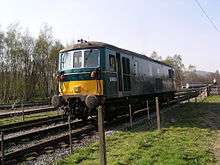
This is effectively an electric locomotive with a relatively small auxiliary diesel prime mover intended only for low-speed or short-distance operation (e.g. British Rail Class 73). Some of these, such as the British Rail Class 74, were converted from electric locomotives. The Southern Region of British Railways used these locomotives to cross non-electrified gaps and to haul boat trains that used tramways at the ports of Southampton and Weymouth. For economy, the diesel engine and its generator are considerably smaller than the electric capacity. The Southern types were of 1,600 hp or 'Type 3' rating as electrics, but only 600 hp as diesels.[1] Later classes had as much as 2,500 hp on electric power, but still the same diesel engines. Despite this large difference, their comparable tractive efforts were much closer (around three-quarters as diesels) and so they could start and work equally heavy trains as diesels, but not to the same speeds.
Primarily diesel
This is effectively a diesel locomotive with auxiliary electric motors (or connections to the existing traction motors), usually operating from 750 V DC third rail where non-electric traction is banned (e.g. EMD FL9, GE Genesis P32AC-DM, EMD DM30AC). The primary function for these models is to provide a "one-seat ride" (a rail trip that doesn't require a transfer to a different train) between the electrified and non-electrified sections of a rail system or to allow trains to run through tunnels or other segments of track where diesel locomotives are generally prohibited due to their production of exhaust; such locomotives are used for certain trains servicing the New York City terminals of Grand Central Terminal and Penn Station, as the various rail tunnels into Manhattan have exhaust restrictions. Once out of the tunnels, the engines are started and operation is as a normal diesel locomotive.
Full dual-mode
With modern electronics, it is much easier to construct (or adapt) an electro-diesel locomotive or multiple-unit which is equally at home running at high speeds both "under the wires" and under diesel power (e.g. SNCF Class B 82500, Bombardier ALP-45DP). These will normally operate under pure electric traction where possible, and use the diesel engines to extend the journeys along non-electrified sections which would not be cost effective to electrify. They may also be used on long cross-country routes to take advantage of shorter sections of electrified main lines.
Europe
France
Bombardier has built dual-mode variants of its AGC series[2] for the French operator SNCF; the electricity is collected by means of a pantograph.
- B 81500 – multiple unit trains using 1.5 kV DC catenary, in service since 2005
- B 82500 – multiple unit trains using both 1.5 kV DC and 25 kV AC catenary, currently still being built
Germany
- Gmeinder class 478.6 diesel and 750 V DC third-rail (bottom contact).
- Voith Futura, a concept locomotive rebuilt from DB 240 002.
- Bombardier TRAXX "Last Mile Diesel", mainly electric. Orders signed 2010, to be delivered probably 2012.[3]
Italy
- Five Electro-diesel versions of the Stadler Flirt have been ordered for service in the Valle d'Aosta region.[4]
Poland
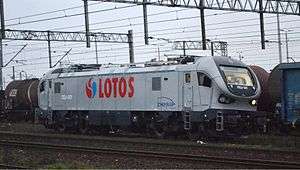
- Pesa 111Ed Gama Marathon – mainly electric, with auxiliary diesel engine enabling last-mile operation on non-electrified tracks. Gama Marathon was first presented in 2012 at InnoTrans Berlin. The locomotive then underwent a series of tests with rail operators Lotos Kolej (in goods traffic) and PKP Intercity (in passenger traffic),[5][6] after successful conclusion it was offered on the market.[7] In July 2015 the Polish train-operating company Locomotiv bought the prototype and signed order for further two Marathons.[8]
- Newag Dragon – version of this electric freight locomotive for the Freightliner's Polish branch, Freightliner PL Sp. z o.o. (five units delivered in 2016) is equipped with auxiliary diesel engine.[9]
- Newag Griffin – a version of this electric freight locomotive, leased to Lotos Kolej in 2017 for 7 years with a provision to extend the lease, is equipped with auxiliary diesel engine.[10]
Russia
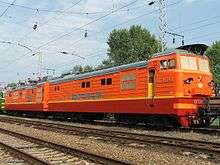
In Russia, a number of electro-diesels were built which had both pantographs and diesel prime movers; these locomotives were actually multiple units, with distinct electric, diesel, and motor sections. These included:
- ED16 (ЭД16), ED18 (ЭД18), and TEU1 (ТЭУ1) narrow gauge models
- OPE1 (ОПЭ1), OPE2 (ОПЭ2), NP1 (НП1), PE2(M) (РЭ2(М)), and EL20 standard-gauge locomotives used mostly in quarries
- DT1 (ДТ1) standard-gauge multiple unit
Spain
- FEVE 1.900 Series, 1500 V DC overhead wires. This series is a rebuild of FEVE 1.000 Series locomotive.
- CAF Bitrac 3600, 3000 V DC overhead wires. October 2007 order for nine freight Co-Co locomotives.[11] Available in Bo-Bo and Co-Co wheel configuration, 1,435 or 1,668 mm (56.5 or 65.7 in) gauge, and as freight or passenger versions of 120 and 180 km/h (75 and 112 mph) maximum speeds respectively.[12]
Switzerland
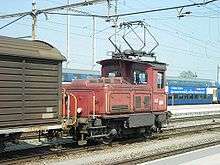
- Rhaetian Railway Gem 4/4 801 and 802, 1000 V DC overhead wires (Bernina Railway)
- Swiss Federal Railways Tem I 251–275 (1950–57), Tem II 276–298 (1967) and Tem III 321–365 (1954–62) shunters (Tem III see image) of which only few are still in service.
- Swiss Federal Railways Eem 923 shunters using both 15 kV 16.7 Hz and 25 kV 50 Hz overhead wires and a 360 kW auxiliary diesel engine are on delivery from Stadler Rail's Winterthur plant.[13]
United Kingdom
An experimental electro-diesel locomotive, DEL120, was built by London Underground in 1940 but was not a success. Two types have been built whose electricity source was a 750 V DC third rail.
- British Rail Class 73, dating from 1962 – the more successful design, with some still in regular use. They originally had lower power output in the diesel mode, but are being re-engined to provide more power (2014, 50 years since introduction).
- British Rail Class 74 – rebuilt from British Rail Class 71 electric locomotives in 1967 and withdrawn by 1977.
Electro-diesel locomotives and multiple units whose electricity source is 25 kV 50 Hz AC overhead line include:
- British Rail Class 88 – locomotive used by Direct Rail Services. Introduced in 2017.
- British Rail Class 755 – multiple unit for use on Greater Anglia regional services. Introduction from 2019.
- British Rail Class 769 – multiple unit converted from Class 319, for use on Arriva Trains Wales and Northern regional services. Introduction from 2018.
- British Rail Class 800 – high-speed multiple unit for use on Great Western Railway and London North Eastern Railway inter-city services. Introduction from October 2017.
- British Rail Class 802 – high-speed multiple unit for use on Great Western Railway, Hull Trains and TransPennine Express inter-city services. Introduction from December 2018.
In 2010, Bombardier had plans,[14] apparently known as Operation Thor or Project Thor, to convert 500 existing diesel multiple units (DMUs) into electro-diesel multiple units (EDMUs).[15] Whilst exact details are unclear, one source specified that these would involve their Voyager family DEMUs, and entail the construction of additional intermediate cars with a pantograph and a transformer which would feed power into the traction motors of the existing diesel-electric cars when running off overhead lines.[16]
North America
Canada
- Bombardier ALP-45DP – 20 locomotives are on order for the Mascouche line (AMT). It is a joint order with the New Jersey Transit order above.[17] They will provide a through journey on this mostly un-electrified new line, which joins an existing electrified commuter line to access Montreal's Central Station through the poorly ventilated, 25 kV AC electric only Mount Royal Tunnel.[17]
United States
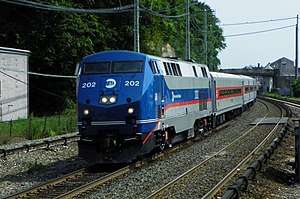
Several, primarily diesel locomotive types and a multiple-unit have been built to operate off a 750 V DC third rail into the New York City terminals of Grand Central Terminal and Penn Station. The following are in service:
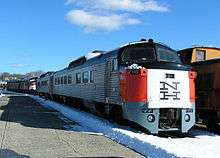
- P32AC-DM – dual-mode version of the GE Genesis, electric mode is only used for a few miles of travel.
- EMD DM30AC – specific to the Long Island Rail Road, the electric mode is only used for service to Penn Station.
- Bombardier ALP-45DP[2] – 35 locomotives were purchased by NJ Transit, to bridge gaps between non-electrified and electrified sections of track into New York Penn Station.[17][18] These trains have been used to provide a "one-seat ride" to New York Penn Station both for commuters using non-electrified portions of the system.[19]
The following were retired from New York City service:
- Baldwin RP-210 – primarily diesel-hydraulic, third-rail electric mode for short-term use only.
- "Roger Williams" streamlined, six car, lightweight, DMU passenger train, built by the Budd Company in 1956 for the New York, New Haven and Hartford Railroad – primarily diesel-hydraulic, third-rail electric mode for short-term use only.
- Fairbanks Morse P-12-42 – primarily diesel-electric, third-rail electric mode for short-term use only.
- EMD FL9 – primarily diesel-electric, third-rail electric mode for short-term use only.
- GE three-power boxcab - tri-mode switcher locomotive model built in 1930, was also capable of operating as a battery locomotive, All retired and scrapped.
- GE/Garrett Gas Turbine MUs - primarily electric, but built with Gas Turbines to allow operation outside of third rail electrification. All scrapped.
Africa
South Africa
The South African Class 38-000 is a 3 kV DC electro-diesel locomotive designed by Consortium under the leadership of Siemens and built by Union Carriage and Wagon (UCW) in Nigel, Gauteng, South Africa. Between November 1992 and 1993 fifty of these locomotives were placed in service by Spoornet, formerly the South African Railways (SAR) and later renamed Transnet Freight Rail (TFR). The diesel engine enables the locomotive to shunt on unelectrified sidings.[20]
Hybrid locomotive

A specialized type of electro-diesel locomotive is the hybrid locomotive. Here, the electricity comes from a battery charged by the diesel engine rather than from an external supply. An example is the Green Goat switcher GG20B by Railpower Technologies, a subsidiary of R.J. Corman Railroad Group since 2009.[21]
See also
- Biodiesel
- Dual-mode bus
- GE "Three-Power" boxcab
- Hitachi Super Express, a future train for the United Kingdom
References
- ↑ Allen, G. Freeman (1962). British Railways Today and Tomorrow (3rd ed.). Ian Allan. pp. 88–89.
- 1 2 "MITRAC Hybrid The Dual Power Propulsion Chain" (PDF). Bombardier.
- ↑ "Bombardier launches Traxx electro-diesel". Railway Gazette International. 10 May 2011. Archived from the original on 12 May 2011. Retrieved 11 May 2011.
- ↑ http://www.railwaygazette.com/news/traction-rolling-stock/single-view/view/first-electro-diesel-flirts-ordered.html
- ↑ "GAMA On Test". Railvolution. 5 December 2012. Retrieved 20 January 2013.
- ↑ "GAMA Marathon Passenger Debut". Railvolution. 2 March 2013. Retrieved 12 March 2013.
- ↑ "Maraton – a step closer to the perfect locomotive". PESA Bydgoszcz SA. Archived from the original on 6 January 2014. Retrieved 20 January 2013.
- ↑ "Lokomotiv kupił Gamę i chce jeszcze dwie [Zdjęcia] (Locomotiv bought Gama and wants two more [photos])". Rynek Kolejowy (in Polish). 8 July 2015. Archived from the original on 11 July 2015. Retrieved 10 July 2015.
- ↑ Madrjas, Jakub (2 February 2015). "Freightliner PL zamówił nowe Dragony z Newagu (Freightliner PL ordered new Dragons from Newag)". Rynek Kolejowy (in Polish). Retrieved 5 March 2016.
- ↑ Szymajda, Michał (22 May 2017). "Pierwszy Griffin dla Lotos Kolej już gotowy [zdjęcia] (First Griffin for Lotos Kolej is completed [photos]". Rynek Kolejowy (in Polish). Retrieved 22 May 2017.
- ↑ "Customer for CAF's Bitrac electro-diesel locomotive". Railway Gazette International. January 2008.
- ↑ "Electro-diesel loco offers flexible traction". Railway Gazette International. 2008-01-03. Retrieved 2010-12-02.
- ↑ "Electro-diesel shunter order". Railway Gazette International. 2010-07-08. Retrieved 2010-12-02.
- ↑ "Colin Walton: Railway man trying to keep Bombardier on track". The Independent. 2010-06-17. Retrieved 2011-03-04.
- ↑ "Transport and the economy: Memorandum from Bombardier Transportation UK Limited (TE 89)". Parliament of the United Kingdom. 10 November 2010. Retrieved 2011-03-04.
Project Thor, being developed with a number of UK private sector partners, would see 500 existing diesel multiple unit vehicles converted to bi-mode diesel / electric capability, allowing them to operate as electric trains where there is already electrification infrastructure in place, while continuing their journey in diesel mode where the wires end.
- ↑ "Bombardier's electrification plan presented to ministers". Rail-News.com. 2010-10-06. Retrieved 2011-03-04.
Train builder Bombardier has presented ministers with an offer to construct 123 pantograph vehicles and convert 21 existing vehicles in the 22x fleet into EDMUs.
- 1 2 3 "Bombardier to supply electro-diesel locos". Railway Gazette International. 2008-08-19. Retrieved 2010-12-02.
- ↑ "NJ Transit approves FY2011 spending". Railway Gazette International. 2010-07-19. Retrieved 2010-12-02.
- ↑ "NJ Transit to expand one-seat ride on North Jersey Coast Line". New Jersey Transit. 4 May 2014. Retrieved 1 June 2015.
- ↑ Class 38 electro-diesel in operation, Railways Africa.
- ↑ Railpower locomotive production line.
External links
- "Pictures of the Russian OPE-1 locomotives".
- "Pictures of the Russian electro-diesels".
- (in Russian) Novocherkasskiy electric locomotive factory – Model OPE1
- CAF website
- Drehstromloks.de